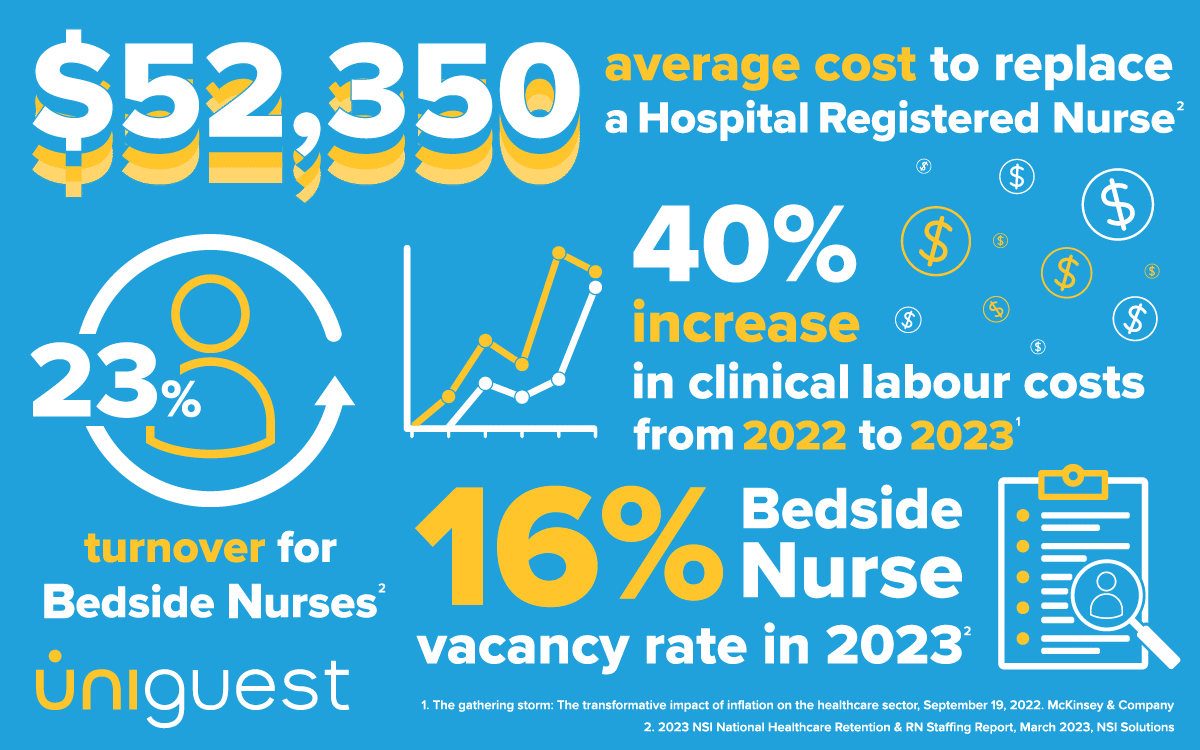In the dynamic landscape of healthcare, the pursuit of nurse retention has become a paramount challenge. Monetary and scheduling incentives, once relied upon, are proving insufficient in meeting the staffing needs of healthcare facilities nationwide. As administrators grapple with the increasing strain on the nursing workforce, a shift toward comprehensive solutions is vital.
The Urgency of Nurse Retention: A Statistical Snapshot
The confluence of rising labor costs and a persistent staffing shortage underscores the critical nature of nurse retention strategies. On average, the cost to replace a hospital nurse is more than 40,000 USD, and from 2022 to 2023, there was a 40% increase in clinical labor costs. In addition to the expense, high turnover can create a poor patient experience and potential harm to the reputation of the hospital. It is important for hospitals to look to modern solutions for a problem that has worsened in the new millennium.

A Technological Revolution: The Interactive Patient Care System
David Muntz, former Principal Deputy National Coordinator with the HHS (Health and Human Services) Office of the National Coordinator for Health Information Technology and past CIO (Chief Information Officers) of multiple large health systems, referred to the hospital TV as a hearth, a calm gathering point for patients, families, and staff in a very hectic environment. This is a great analogy. Expanding on that idea, the interactive patient care system (IPS) transforms the TV in into a collaborative care communication hub for entertainment (of course) but also education and empowerment. It is within the realm of empowerment the IPS shines at helping with nurse satisfaction and retention. In aggregate, there are 4 Key areas in which the IPS Supports Nursing:
- Automating Repetitive Tasks
- End-to-end integration with the EHR (Electronic Health Records) and other HIT automates task such as dispensing and documenting patient education allowing nurses to focus on time with the patient.
- Automated careflows for infection control, falls prevention, pain management, medication education, and discharge planning streamline adherence with quality, safety, and Joint Commission standards,
- Foster Better Patient Outcomes
- Enhancing collaboration and communication for improved patient self-efficacy post-discharge
- Leveraging automated learning verification so staff is confident patients are ready for discharge.
- A Focus on Patient Care and Top-of-License Practice
- Allowing patients to manage nonclinical tasks
- Enabling nurses to focus more fully on clinical care, boosting job satisfaction
- Offer Staff Appreciation Opportunities
- Integrating with partner organizations like DAISY and Wambi for personalized thank-you’s
- Real-Time Feedback Surveys and Rounding to capture opportunities for service recovery and appreciation
One System – Multiple Touchpoints
Today’s IPS can integrate with multiple hospital systems (EHR, Nurse Call, Engineering, Dietary, RTLS, Pharmacy, etc.) and can create multiple opportunities and touch points for care collaboration right in the hospital room. These include:
The SMART TV – Your hospital grade SMART TV is the anchor point of the IPS system. In addition to the positive distraction benefits of entertainment and relaxation programming, it is the primary access point for patient education and communication through the pillow speaker.
BYOD – Via device pairing, patients and families can control an IPS via their personal mobile devices. This can help improve engagement by patients and families with the IPS.
Digital Whiteboards – Enhance collaboration and communication with clear displays, fostering an environment of enhanced patient care. The digital whiteboard pulls data from multiple sources including daily schedules, medication details, and more in real time providing current information while relieving the nurse team of manual updates to dry erase boards.
Digital Door Signs – Provide critical information like precautions, falls risk, and allergies to care teams at room entry to better prepare staff for each encounter. PIN-accessed, touchscreen controls allow staff to manage the IPS with minimal disruption to patients.
In Room Telepresence – Simplify virtual visits from staff, interpretive services, and family and friends using the existing TV infrastructure. Remove the need for expensive peripheral devices and/or carts. Be sure your system can integrate with hardware/software virtual solutions that may already be in place so you can extend the value those investments.
Investing in a system that is delivers a modern-day solution should also be future proof. With rapid changes to be technology and the importance of correctly managing data, it is important that your IPS can scale. Join us at AONL (American Organization for Nursing Leadership) 2024 to witness the future of healthcare unfold at pCare by Uniguest’s booth #720. Explore the Interactive Patient Care System and discover how it can elevate patient care, nurse satisfaction, and overall healthcare experiences.